by Donna Arnold | Aug 15, 2025
Kalanchoe Species in Florida: Invasive Threats and Management
Several species of Kalanchoe, widely distributed through horticulture as popular containers and landscape plants, have escaped cultivation and become invasive in Florida. Of the approximately seven species reported outside of cultivation, two have been documented as particularly problematic: Kalanchoe pinnata (commonly known as Cathedral Bells) and Kalanchoe × houghtonii (known as Mother of Millions). Both are listed as Category II invasive plants by the Florida Invasive Species Council (FISC), indicating they have the potential to disrupt native ecosystems. “In Central and South Florida, the plant is listed as invasive; hhowever, there is a cautionary note for North Florida.”
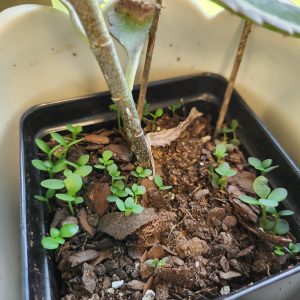
Photo Credit: Donna Arnold, FAMU Extension
Kalanchoe × houghtonii is a hybrid of K. delagoensis and K. daigremontiana, which has led to some confusion in reporting and distribution records. These species belong to the Crassulaceae family and are characterized as succulent herbs with hollow, fleshy stems. K. pinnata features rounded, scalloped leaves, while K. × houghtonii has slender, pointed, fleshy leaves. Their bell-shaped, pendulous flowers range in color from green to red. In Florida, these plants are primarily found in South Florida and along the East Coast, extending as far north as Nassau County.
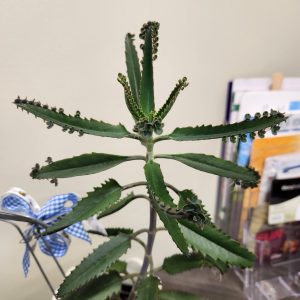
Photo Credit: Donna Arnold, FAMU Extension
The ecological impacts of Kalanchoe species are significant. Reproduction occurs both sexually and vegetatively, with plantlets forming along leaf margins and even on inflorescences. This species high reproductive rate and ability to thrive in dry, arid environments allow them to invade coastal dune habitats, where they form dense carpets that crowd out native species. Shallow root systems contribute to destabilization of sandy areas by displacing native plants such as sea oats, which are essential for anchoring sand and preserving dune integrity.
Effective management begins with prevention. Homeowners are advised not to plant Kalanchoe species and to avoid dumping landscape material in natural or disturbed areas. Physical control methods include hand-pulling and secure disposal of plant material to prevent regrowth. Chemical control can be achieved using a 5% glyphosate foliar spray, which is effective in killing individual leaves that might otherwise produce new plantlets. Follow-up removal of detached leaves is essential to prevent further spread. Currently, there are no known biological control methods for these species.
For more information and personalized management recommendations, homeowners should consult their local UF/IFAS Extension office. Additional resources are available through the UF/IFAS Center for Aquatic and Invasive Plants, and the Florida Invasive Species Council Plant List.
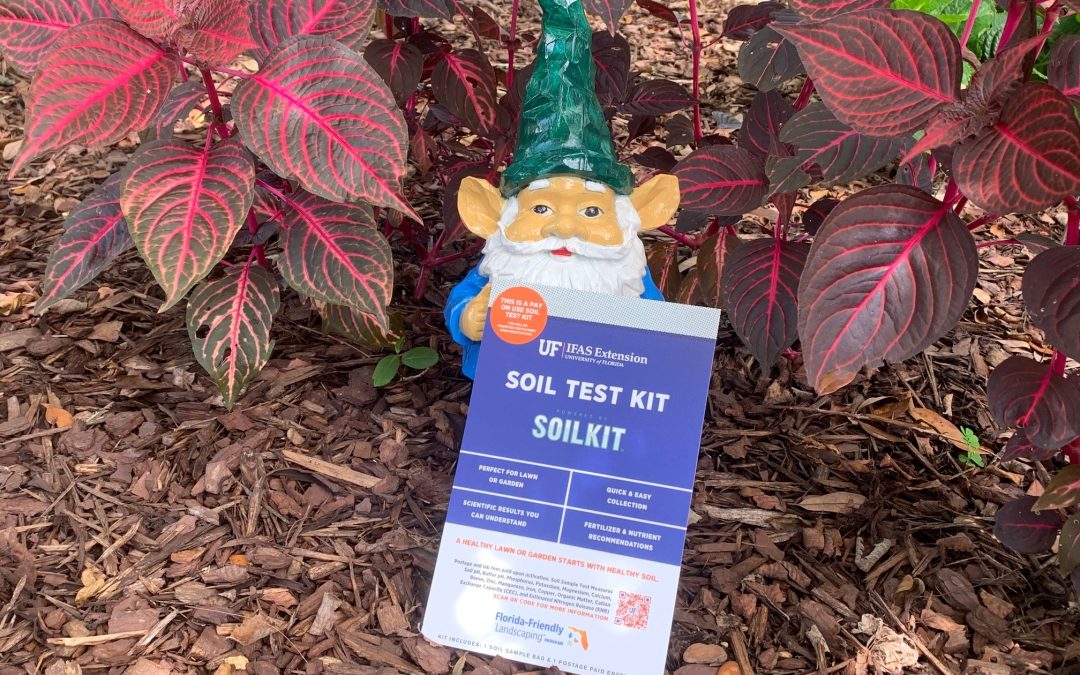
by Beth Bolles | Aug 9, 2025
You have probably heard about the SoilKit testing option that is available at local UF IFAS Extension offices. Why would you want to use a new testing kit when the traditional soil testing kit is still available ?
UF IFAS Extension SoilKit is an option for those who want their turfgrass test results based on the latest evidence-based science. This is especially important when dealing with the application of phosphorus, a potentially polluting nutrient. If your soil measures adequate phosphorus for our warm season turfgrasses, you don’t want to add more.
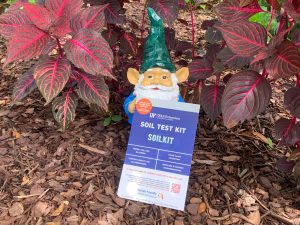
UF IFAS Extension SoilKit. Photo by Beth Bolles, UF IFAS Extension Escambia County.
The good news is that UF IFAS turfgrass research has established thresholds for when nutrients like phosphorus are needed. SoilKit is aligned with these thresholds and will only recommend nutrients based on the evidence-based science.
SoilKit does cost more than the traditional soil testing. The convenience is that it includes postage so you put it directly in your mailbox for pickup. Another positive is that when you register your kit online, you can locate your home on a map and mark the square footage of the lawn area. When you get your results in a few days, there is no guess work. You will get a list of products and amounts to purchase for your size lawn.
SoilKit can be used to test other plant groups including gardens and shrubs. If you have questions about using SoilKit, your local Extension office can help.
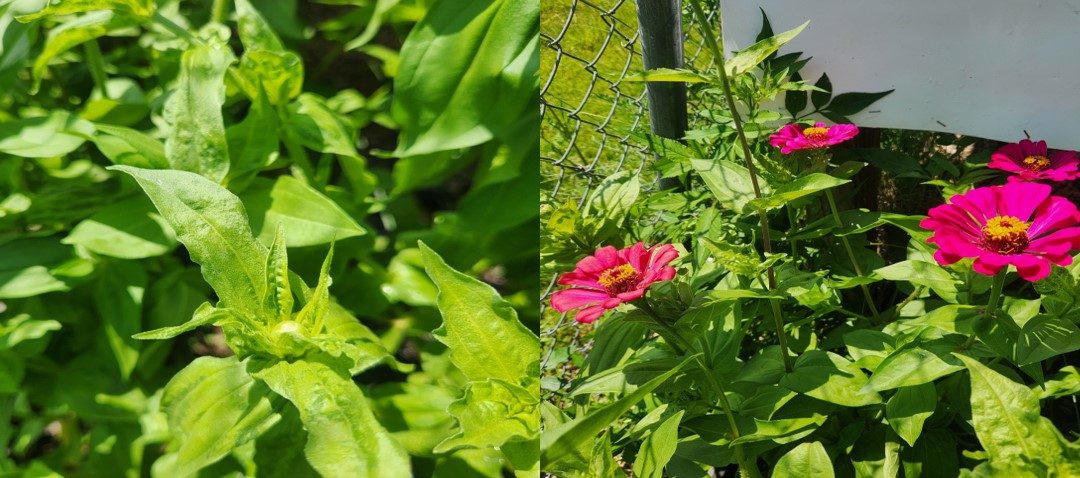
by Donna Arnold | Jul 6, 2025
Zinnia Woes: What’s Causing Terminal Shoot Curling?
On a quiet stroll to the greenhouse early Monday morning, something unusual caught my eye—our zinnia plants looked noticeably different. Their vibrant green shoots had begun to curl at the tips, a subtle but clear sign that all was not well. Do not be alarmed if your zinnias are showing similar symptoms—it is a common issue. Curling at the terminal shoots is often a plant’s way of signaling stress. Whether it is due to environmental factors, pest activity, or nutrient imbalance, these twisted tips are clues worth investigating. Understanding the “why” behind the curl is the first step toward helping your zinnias return to their radiant, blooming selves
Common Culprits Behind Curling Zinnias
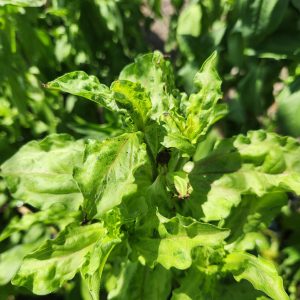
Environmental Stress: Zinnias are sun-lovers, but extreme heat, strong winds, or sudden temperature swings can cause their terminal shoot to curl as a defense mechanism.
Watering Woes: Both overwatering and underwatering can lead to leaf curls. Too much water suffocates roots, while too little causes drought stress—either way, the plant reacts by curling its leaves.
Pests: Aphids, thrips, and spider mites are notorious for feeding on tender new growth. Their sap-sucking habits distort leaves and can transmit viruses.
Diseases: Fungal infections like powdery mildew or bacterial leaf spot can cause curling, especially when combined with poor air circulation.
Nutrient Deficiencies: A lack of nitrogen, magnesium, or manganese can lead to curling and yellowing of new growth. Soil testing can help pinpoint the issue.
What You Can Do:
- Ensure consistent watering—moist but not soggy soil is ideal.
- Inspect regularly for pests and treat with neem oil or insecticidal soap.
- Improve air circulation by spacing plants properly and pruning overcrowded areas.
- Feed with a balanced fertilizer and consider a soil test if symptoms persist.
- Remove and destroy severely affected plants to protect the rest of your garden.
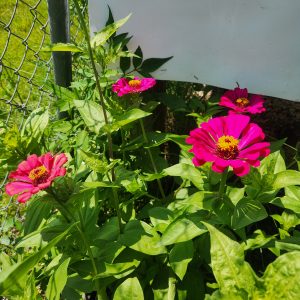
Healthy zinnias reward you with bold, cheerful blooms. A little detective work now can keep your garden dazzling all season long. For more information on Zinnias, contact your local Extension office or follow the links below.
https://gardeningsolutions.ifas.ufl.edu/plants/ornamentals/zinnia/
https://edis.ifas.ufl.edu/publication/FP623
https://nwdistrict.ifas.ufl.edu/hort/category/annuals-2/page/2/#:~:text=When%20planting%20zinnias%2C%20it’s%20recommended,than%20the%20foliage%20whenever%20possible.
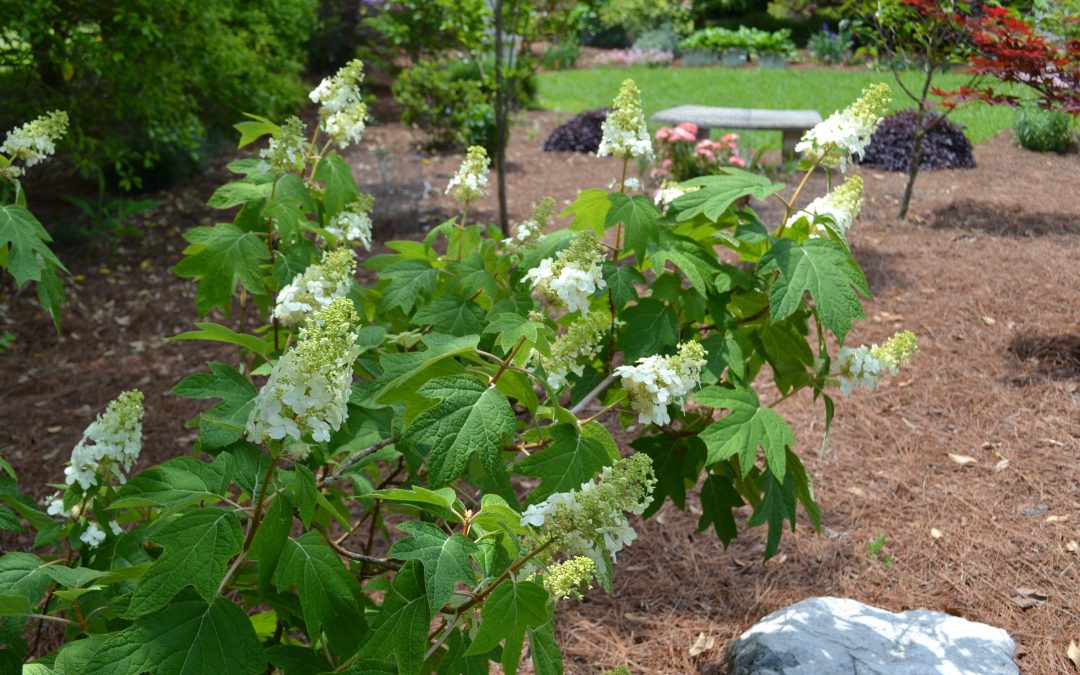
by Beth Bolles | Jun 20, 2025
Shade is a wonderful feature in the landscape as we move into our summer months. It can also offer an opportunity to include a different palette of beautiful plants the bring color and brighteness to some filtered shade or full shade locations.
Here are a few plants to consider for those low light areas of the yard.
The native oakleaf hydrangea, Hydrangea quercifolia will do well in dappled shade spots. The leaves are attractive on their own but the addition of large flowers make it very showy. This native hydrangea will like a little moisture but soils should be well drained. A little morning sun is fine but afternoon shade is very helpful as the summer months progress.
The old standard Japanese aucuba, Acuba japonica, is a favorite with it’s green leaves speckled with yellow. New growth is damaged by sun so this evergreen shrub is best with a good amount of shade. Be sure to place in a spot with good air circulation to make the environment less conducive to some plant pests.
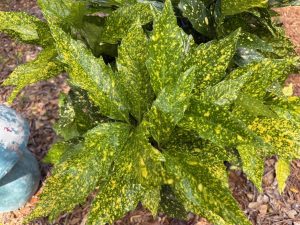
Each Aucuba leaf has a unique pattern. Photo by Beth Bolles, UF IFAS Extension Escambia County.
One of the shrimp plants that really needs shade is the White shrimp plant, Justicia betonica. Although this can be damaged in freezing weather, it is worth replanting every spring in a small grouping. Plants are easily started from cuttings and sometimes they will return from roots in the protected shade areas.
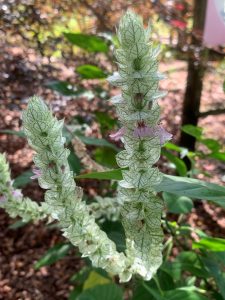
White bracts with pink flowers of White shrimp plant. Photo by Beth Bolles, UF IFAS Extension Escambia County.
An annual that is very showy for shade is related to the shrimp plant. Persian shield, Strobilanthes dyerianus is grown for it’s iridescent purple and silver foliage. It thrives in our heat with a little water when rainfall is lacking. It grows well either planted in the ground or in a container to provide bright color amongst the green foliage plants of your shady spot.

A bit of dappled morning sunlight on the Persian shield leaves. Photo by Beth Bolles, UF IFAS Extension Escambia County.
Most people know the Cast iron plant, Aspidistra elatior, which is a full shade plant. Plants that receive too much sunlight with have scalding spots. Although green foliage is attractive in summer, consider one of the cultivars with various types of variegation. You may choose a selection with white or yellow stripes through leaves or a plant with lots of white spots throughout green leaves.

by Mark Tancig | May 28, 2025
Extension Agents get used to hearing that the local Extension Office is the community’s best kept secret. As much as we try to let folks know we’re here, many are still unaware of the services we provide. Even amongst the residents that are familiar with us, some of the services available remain unknown, especially our identification and diagnostic services. Here’s a rundown on some of the services available through your UF/IFAS Extension service.

Taking a soil sample. UF/IFAS Photo by Tyler Jones
Soil Testing
This is probably our most well-known service, but it’s worth a reminder. For only $3 (pH only) or $10 (pH plus plant macro- and micro-nutrient values) per sample, plus shipping, you can have your soil analyzed in a state-of-the-art facility. To be clear, soil testing only provides a reading of your soil’s chemistry, specifically pH (acidity/alkalinity) and plant nutrient values. It does not provide information on any diseases or potential toxins that may be present in the soil. In addition to the results, you can specify the general type of plant you’re trying to grow (various grass species, vegetables, citrus, general trees and shrubs, etc.) and the report will provide recommendations to adjust the nutrient levels to be sure that plant is able to thrive. Your local agent receives a copy to help answer any questions you may have about the results or recommendations. More about soil and nutrient testing can be found at the Extension Analytical Services Laboratory website.

Experts at the Plant Disease Diagnostic Clinic can identify diseases present. Credit: UF/IFAS.
Plant Disease Diagnosis
UF/IFAS Extension has a great plant pathology lab on campus, but we also have a great resource close by in Gadsden County at the North Florida Research and Education Center’s (NFREC) Plant Disease Diagnostic Clinic. For a modest fee of $30, you can submit a sample of a diseased plant, and the lab manager will use the available methods to confirm the presence of disease and identify the disease-causing organism. Just like with the soil test results, you are provided with a recommendation on how to best treat the disease. The NFREC Plant Disease Diagnostic Clinic website has submittal forms, contact information, and directions for collecting a quality sample.

Need help with insect id? The DDIS system can help. Credit: UF/IFAS.
Plant and Insect Identification
While your local extension agent enjoys receiving plant and insect identification, there is an online submittal option available to use as well through our Distance Diagnostic Identification System (DDIS). You can set up an account and then upload photos of plants, insects, mushrooms, even diseased plants, and an expert on UF’s campus will do their best to identify it for you. The DDIS website has more information to help you set up a user account.
The Florida Cooperative Extension Service has many ways to help Florida citizens diagnose their landscape issues using science-based methods conducted by experts in state-of-the-art facilities. The above services are just a selection of the diagnostic capabilities available. To see a complete list, visit the IFAS Diagnostic Services website. You can always contact your local extension office, too, for assistance in identifying plants and insects, as well as diagnosing diseases.

by Joshua Criss | Mar 6, 2025
Ah, springtime is approaching quickly. You and I both know you’re getting anxious to get out into your gardens to grow your plants. I’m not faulting you, far from it. You’ll find that your local Extension agents want your garden to succeed as much as you do. Because we all want you to have a bountiful harvest, we need to have a conversation about fertility in your lawns and gardens.
Definitions
Before we get too deep into this topic, let’s define nutrition. You may hear some refer to fertilizers as “plant food.” While this is a common phrase concerning fertilizers, it is not factually accurate. Food is associated with energy creation within an organism. Plants are autotrophs, meaning they convert sunlight into energy. So, under this premise, sunlight is plant food, whereas plant nutrition is the building blocks of tissues or catalysts of metabolic processes.
The 17 elements designated as plant essential nutrients are categorized based on the quantity needed for healthy growth. All are important to have in your soil; as per the “Law of the Minimum,” your plant’s development will be limited based on the most deficient element.

UF/IFAS Photo
Macros
Those elements with the largest demand within the plant are known as macronutrients. The three most critical of these are very often absent in fertilizer conversations as they cannot be added to soil in granule form. These are carbon, hydrogen, and oxygen, and their presence in your garden results from your cultural practices. You get them from air and water in the pore spaces of your soil. Appropriate tillage and irrigation are the only ways to provide these elements to your plants. They are critical for proper photosynthesis and fluid balance in the plant.
The most discussed elements are so vital that they make up the three numbers on every bag of fertilizer. These are nitrogen (N), phosphorous (P), and potassium (K), all of which may be added to soil to overcome deficiencies (N often being the limiting factor). These elements are crucial for protein creation, photosynthesis, and fluid movement.
Secondary Nutrition

UF/IFAS Photo: J. Criss
The next set of nutrients have less demand than NPK. They are sulfur (S), magnesium (Mg), and calcium (Ca). Ca is essential for cell structure but is often abundant in our soils. S is frequently rained out of the atmosphere (though you may still need to add some) and facilitates enzymatic processes in plant cells. Mg needs the most attention in this category as it has a lot of mythology among gardeners. You’ve likely heard you should add this element to “green up” your plants. While it is true that Mg is critical to chlorophyll, adding it without testing for deficiencies first is a recipe for poor plant growth.
Micros
Our final category of fertilizer is micronutrients. These are iron (Fe), manganese (Mn), boron (B), chlorine (Cl), zinc (Z), copper (Cu), molybdenum (Mo), and nickel (Ni). These serve various functions in the plant, mainly in metabolic processes.
To Sum Up
Plant fertilization is critical for lawns and gardens. It behooves gardeners to understand these elements and their role in plant growth. Once you do, you’ll understand the importance of applying the correct version of the element in the proper amount at a time and location to maximize use efficiency. You can learn more about what they do and how they react in the soil here. For more information, contact your local extension office.


















